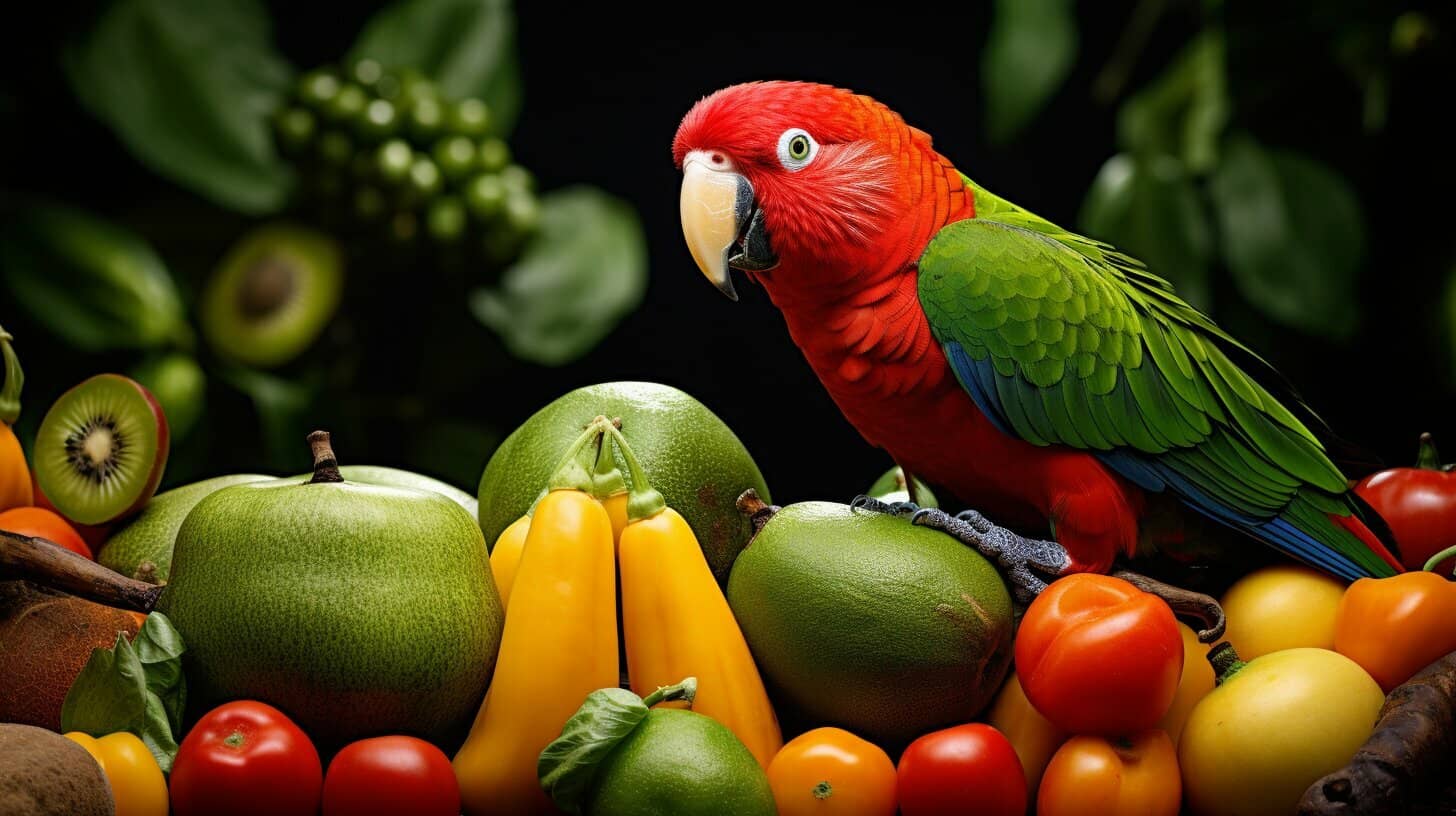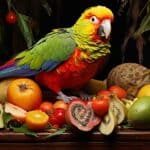If you’re a proud owner of a kakariki, you might be wondering if mealworms can be included in your feathered friend’s diet. These active and beautiful birds require a balanced diet to stay healthy and happy.
Can kakarikis eat mealworms? Yes, kakarikis can eat mealworms. Mealworms are a nutritious treat for these parakeets. However, they should be given in moderation, as part of a balanced diet. Always ensure the mealworms are fresh and free from any harmful chemicals or pesticides. Monitor your kakariki’s reaction to the new food, and consult a veterinarian if you have any concerns about their diet.
In this section, we’ll take a closer look at the topic of whether kakarikis can eat mealworms. We will explore their broader dietary needs, discuss their natural diet, and highlight the nutritional value of mealworms for kakarikis.
Understanding Kakarikis’ Natural Diet
Before we explore whether mealworms can be part of a kakariki’s diet, it is important to first understand what these birds naturally eat and their nutritional requirements.
Kakarikis are omnivorous and require a balanced diet that includes plant- and animal-based foods. In the wild, they feed on a variety of foods such as fruits, berries, seeds, insects, and their larvae. They are known to forage on the ground, in trees, and even in the water.
Regarding their nutritional requirements, kakarikis need a diet rich in protein, carbohydrates, fats, vitamins, and minerals to maintain good health. They also need a consistent supply of fresh water.
In captivity, providing a varied diet mimics their natural food sources to ensure their health and well-being is important. A diet that lacks the necessary nutrients can lead to malnutrition, illness, and even death.
Nutritional Value of Mealworms for Kakarikis
Mealworms can be an excellent source of nutrition for kakarikis. They are rich in protein, which is essential for the growth and maintenance of the bird’s body tissues. In addition, mealworms contain healthy fats and carbohydrates that provide energy to the bird’s body and help maintain its metabolic functions.
One of the biggest advantages of feeding mealworms to kakarikis is that they are a natural source of vitamins and minerals. Mealworms contain high levels of vitamin B12, which is crucial for the bird’s nervous system and energy metabolism. They are also rich in iron, which helps prevent anaemia and supports the bird’s immune system.
Another key benefit of mealworms is that they contain chitin, a fibrous substance that aids digestion and prevents constipation. This is especially important for birds that are prone to digestive problems.
It is important to note that while mealworms can be a beneficial addition to a kakariki’s diet, they should not be the only food source. Variety is key to ensuring that the bird receives a balanced and complete diet.
Nutritional Composition of Mealworms
Mealworms are a rich source of nutrients for kakarikis. Here’s a breakdown of their nutritional composition:
| Nutrient | Amount per 100g |
|---|---|
| Protein | 20g |
| Fat | 13g |
| Carbohydrates | 2g |
| Vitamin B12 | 1110% of daily recommended intake |
| Iron | 8% of daily recommended intake |
As you can see, mealworms are packed with essential nutrients for kakarikis. It is important to feed them in moderation, however, as an excess of any one food item can lead to nutritional imbalances.
Safe Feeding of Mealworms to Kakarikis
While mealworms can be a nutritious addition to a kakariki’s diet, there are some considerations to keep in mind to ensure their safety and well-being.
Firstly, purchasing mealworms from a reliable source is essential, as those from a dubious origin may be contaminated with pesticides or other harmful substances. Also, ensure that the mealworms are fresh and healthy-looking before offering them to your bird. Avoid feeding stale or moldy mealworms, which can cause digestive problems or illness.
It is recommended to feed mealworms to kakarikis in moderation. While they provide high-quality protein, too many mealworms can lead to a protein overload, which can be harmful to these birds. Offer mealworms as a treat or supplement to their regular diet, instead of making them a staple food source.
When feeding mealworms to kakarikis, ensure that they are properly hydrated. Offer a fresh supply of water alongside the mealworms to prevent dehydration, which can lead to health problems.
Finally, monitor your kakariki’s appetite and behavior after introducing mealworms to their diet. Some birds may have an allergic reaction or digestive issues, so watch for any signs of discomfort or distress. If you notice any adverse reactions, discontinue offering mealworms and consult with a veterinarian.
Incorporating Mealworms into a Kakariki’s Diet
If you’re considering adding mealworms to your kakariki’s diet, you should keep a few things in mind to ensure their safety. Here are some tips for incorporating mealworms into a kakariki’s diet:
- Start small: Introduce mealworms gradually, starting with just a few at a time to see how your kakariki responds to them.
- Offer in moderation: While mealworms are a nutritious addition to your kakariki’s diet, they should only be offered in moderation. Too many mealworms can upset your bird’s digestive system.
- Choose high-quality mealworms: Select mealworms from a reputable source to ensure they’re free from harmful chemicals or contaminants.
- Ensure proper storage: Store your mealworms in a cool, dry place to prevent them from spoiling or attracting pests.
- Vary your kakariki’s diet: While mealworms can be a great source of protein for your kakariki, it’s important to provide a varied diet that includes other foods, such as fresh fruits and vegetables.
By following these tips, you can safely and effectively incorporate mealworms into your kakariki’s diet, providing them with the nutrients they need to thrive.
Mealworms as a Protein Source for Kakarikis
Protein is an essential nutrient for kakarikis as it helps grow and repair their body tissues. While several food options can provide protein, mealworms are an excellent source of this nutrient for these birds.
A mealworm is a darkling beetle larva with a soft body that makes it easily digestible for kakarikis.
Mealworms are also low in fat and high in protein, making them an ideal food choice for kakarikis. They contain about 20% protein, which is higher than most other insects, and are also rich in essential amino acids that help maintain healthy muscles and tissues. Furthermore, mealworms are easy to find in pet stores and online, making them a convenient option for kakariki owners.
It is best to offer mealworms to kakarikis in moderation, along with a well-rounded diet consisting of fruits, vegetables, and seeds. Ensure that the mealworms are fresh and properly stored to prevent any risk of bacteria or parasites.
To prevent overfeeding and ensure that your kakarikis are getting a balanced diet, monitoring their food intake and consulting with an avian veterinarian for dietary advice specific to your bird.
Incorporating Mealworms into a Kakariki’s Diet
Mealworms can be a great addition to a kakariki’s diet and offer a variety of nutritional benefits. Here are some tips on incorporating mealworms into your bird’s diet:
- Start slow: If your kakariki has never had mealworms before, introduce them gradually. Offer just a few at a time and see how your bird responds.
- Offer a balanced diet: Mealworms should not be your kakariki’s sole source of nutrition. Make sure to provide a balanced mix of fruits, vegetables, and other proteins.
- Keep them fresh: Only offer mealworms that are still alive or freeze-dried. Avoid using mealworms that have been sitting out for too long or have gone bad.
- Don’t overdo it: While mealworms can be a healthy addition to a kakariki’s diet, too many can be harmful. Offer them in moderation and don’t let them make up more than 10% of your bird’s overall diet.
If you follow these guidelines, feeding mealworms to your kakariki can be a safe and enjoyable experience for both you and your bird.
Mealworms and Kakarikis’ Health
When included in a kakariki’s diet, mealworms can offer a range of health benefits. Firstly, they are a fantastic source of protein, which is essential for a bird’s growth and development. Protein also supports the maintenance of healthy feathers, which is important for kakarikis, given their active lifestyles.
Mealworms also contain beneficial elements like vitamins B and E, which help to maintain a healthy immune system, protecting birds from illnesses and infections. Additionally, mealworms are low in fat, making them a healthy snack option for kakarikis when offered in moderation.
It is worth noting, however, that mealworms should not be the only source of nutrition in a kakariki’s diet, as their nutritional needs are complex and require a varied selection of foods. Nevertheless, mealworms can contribute significantly to a kakariki’s overall health and wellbeing when fed appropriately.
Tips for Feeding Mealworms to Kakarikis
Feeding mealworms to your kakariki can provide a valuable source of nutrition, but it is important to do it right. Here are some tips to ensure your feathered friend stays happy and healthy:
- Introduce mealworms in small quantities: Start by offering a small amount of mealworms to your kakariki and see how they react. If they enjoy them, you can gradually increase the amount over time.
- Offer mealworms as a treat: Mealworms can be high in fat, so it’s best to offer them as an occasional treat rather than a regular part of your kakariki’s diet. This will help prevent obesity and other associated health issues.
- Buy from a reliable source: When purchasing mealworms, ensure they come from a reputable source. This will help ensure they are safe and free from any harmful chemicals or bacteria.
- Keep mealworms fresh: Store your mealworms in a cool, dry place to help keep them fresh. Avoid exposing them to direct sunlight or high temperatures, as this can cause them to spoil more quickly.
- Offer a variety of foods: While mealworms can be a great source of protein, it’s important to offer a variety of other foods to meet your kakariki’s nutritional needs. This can include fruits, vegetables, and seeds.
- Monitor your kakariki’s health: Keep an eye on your kakariki’s weight and overall health when feeding them mealworms. If you notice any changes or issues, such as weight gain or digestive problems, it may be best to cut back or stop feeding them mealworms altogether.
By following these simple tips, you can safely and effectively incorporate mealworms into your kakariki’s diet and provide them with the nutrition they need to thrive.
Frequently Asked Questions about Feeding Mealworms to Kakarikis
If you’re considering adding mealworms to your kakariki’s diet, you may have some questions. Here are some commonly asked questions and their answers.
Can kakarikis eat mealworms?
Yes, kakarikis can certainly eat mealworms. In fact, they can be a valuable source of protein for these birds. However, offering them in moderation and alongside other foods is important to ensure a balanced diet.
How often can I feed mealworms to my kakariki?
Offering mealworms to your kakariki no more than two to three times a week is recommended. This ensures that they are getting a variety of foods and not relying solely on mealworms for nutrition.
How should I prepare mealworms for my kakariki?
Mealworms can be offered to kakarikis in a variety of forms including fresh, dried, or freeze-dried. Before feeding them to your bird, make sure to wash them thoroughly and remove any debris or dust.
Are mealworms safe for my kakariki to eat?
As long as they are obtained from a reputable source and properly prepared, mealworms are safe for kakarikis to eat. However, it’s important to keep an eye on your bird and monitor for any adverse reactions.
Can mealworms cause health problems for my kakariki?
In general, mealworms are a nutritious addition to a kakariki’s diet and should not cause any health problems. However, if fed in excess, they could contribute to obesity or digestive issues.
How can I tell if my kakariki likes mealworms?
Kakarikis are known to be curious and adventurous when it comes to food, so it’s likely that they will enjoy the addition of mealworms to their diet. However, every bird is different, so it’s important to observe their behaviour and note which foods they prefer.
Can mealworms be used as a training treat for my kakariki?
Yes, mealworms can be an excellent training treat for kakarikis. They are small, easy to handle, and highly motivating for these birds. Just make sure to use them in moderation and alongside other positive reinforcements.
Are there any alternatives to feeding mealworms to my kakariki?
Yes, there are a variety of other foods that can be included in a kakariki’s diet including fresh fruits and vegetables, pellets, and seeds. It’s important to offer a balanced diet that meets your bird’s nutritional needs.
By following these guidelines and monitoring your kakariki’s behaviour and health, you can safely incorporate mealworms into their diet and provide them with a nutritious food source that they will enjoy.



Have comments or questions about this article? Then get involved!
Spotted an error or something we have missed? Let us know